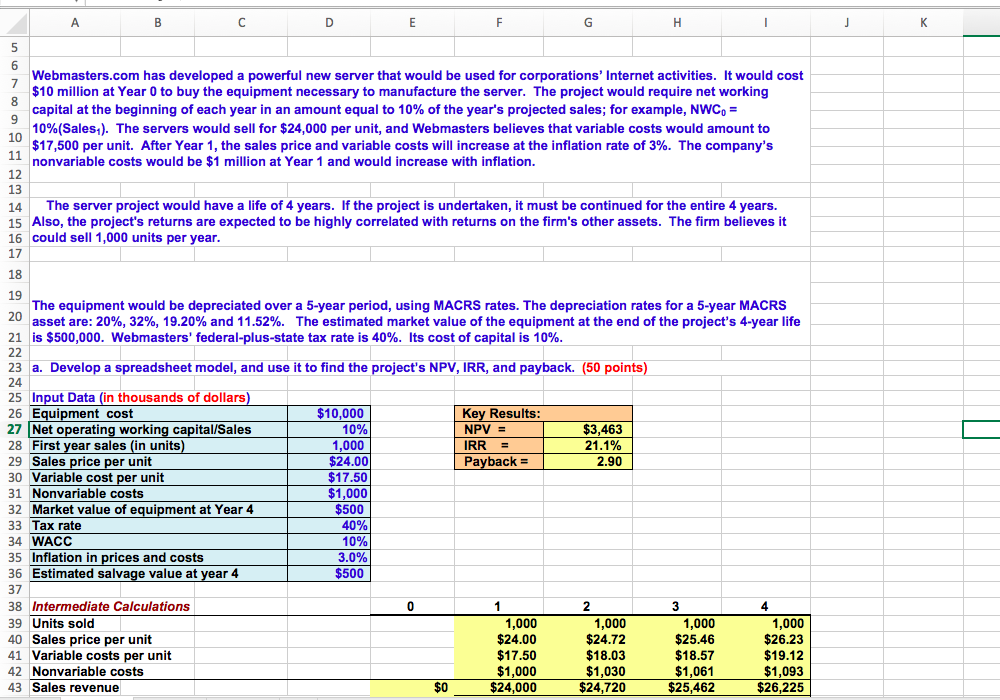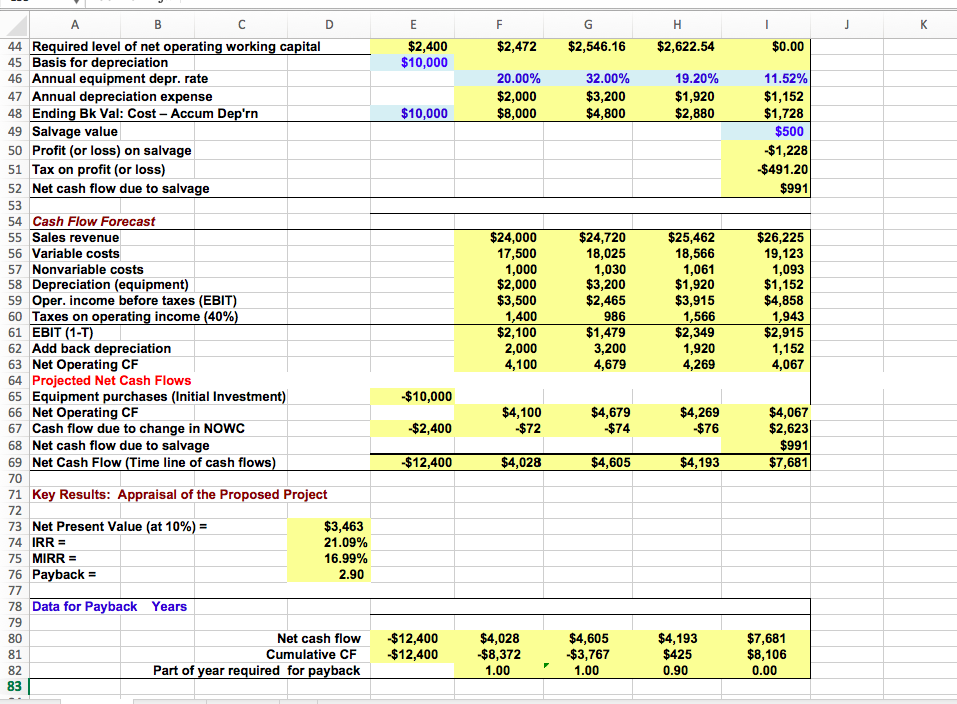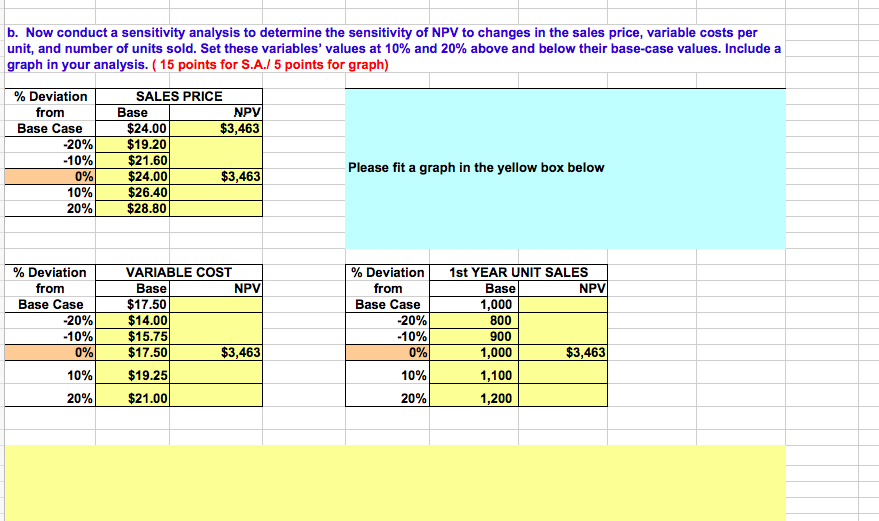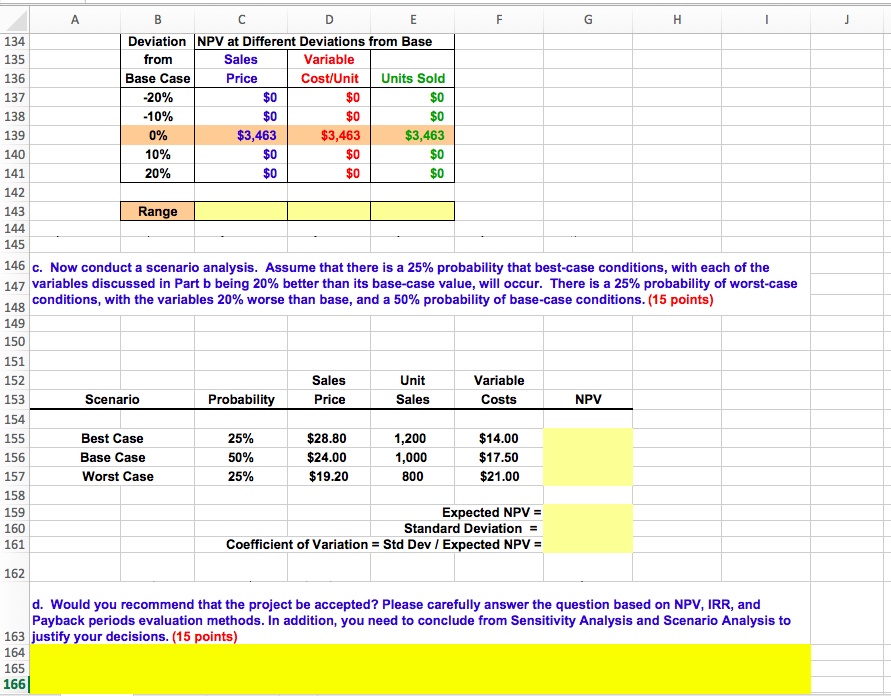PLEASE ANSWER PART B, C, AND D!
PLEASE SHOW THE FORMULA SHEET, NOT JUST THE EXCEL WITH THE NUMBERS. THANK YOU



Webmasters.com has developed a powerful new server that would be used for corporations' Internet activities. It would cost $10 million at Year O to buy the equipment necessary to manufacture the server. The project would require net working capital at the beginning of each year in an amount equal to 10% of the year's projected sales; for example, NWCO = 10%(Sales). The servers would sell for $24,000 per unit, and Webmasters believes that variable costs would amount to $17,500 per unit. After Year 1, the sales price and variable costs will increase at the inflation rate of 3%. The company's nonvariable costs would be $1 million at Year 1 and would increase with inflation. 14 The server project would have a life of 4 years. If the project is undertaken, it must be continued for the entire 4 years. 15 Also, the project's returns are expected to be highly correlated with returns on the firm's other assets. The firm believes it 16 could sell 1,000 units per year. The equipment would be depreciated over a 5-year period, using MACRS rates. The depreciation rates for a 5-year MACRS asset are: 20%, 32%, 19.20% and 11.52%. The estimated market value of the equipment at the end of the project's 4-year life is $500,000. Webmasters' federal-plus-state tax rate is 40%. Its cost of capital is 10%. 23 a. Develop a spreadsheet model, and use it to find the project's NPV, IRR, and payback. (50 points) 24 | Key Results: Key Res NPV = IRR = | Payback = $3,463 21.1% 2.90 25 Input Data (in thousands of dollars) 26 Equipment cost 27 Net operating working capital/Sales 28 First year sales (in units) 29 Sales price per unit 30 Variable cost per unit 31 Nonvariable costs 32 Market value of equipment at Year 4 33 Tax rate 34 WACC 35 Inflation in prices and costs 36 Estimated salvage value at year 4 37 38 Intermediate Calculations 39 Units sold 40 Sales price per unit 41 Variable costs per unit 42 Nonvariable costs 43 Sales revenue $10,000 10% 1,000 $24.00 $17.50 $1,000 $500 40% 10% 3.0% $500 1,000 $24.00 $17.50 $1,000 $24,000 1,000 $24.72 $18.03 $1,030 $24,720 1,000 $25.46 $18.57 $1,061 $25,462 1,000 $26.23 $19.12 $1,093 $26,225 $0 H E $2,400 $10,000 F $2,472 G $2,546.16 $2,622.54 $0.00 20.00% $2,000 $8,000 32.00% $3,200 $4,800 19.20% $1,920 $2,880 $10,000 11.52% $1,152 $1,728 $500 -$1,228 -$491.20 $991 C D 44 Required level of net operating working capital 45 Basis for depreciation 46 Annual equipment depr. rate 47 Annual depreciation expense 48 Ending Bk Val: Cost - Accum Depirn 49 Salvage value 50 Profit (or loss) on salvage 51 Tax on profit (or loss) 52 Net cash flow due to salvage 53 54 Cash Flow Forecast 55 Sales revenue 56 Variable costs 57 Nonvariable costs 58 Depreciation (equipment) 59 Oper. income before taxes (EBIT) 60 Taxes on operating income (40%) 61 EBIT (1-T) 62 Add back depreciation 63 Net Operating CF 64 Projected Net Cash Flows 65 Equipment purchases (Initial Investment) 66 Net Operating CF 67 Cash flow due to change in NOWC 68 Net cash flow due to salvage 69 Net Cash Flow (Time line of cash flows) $24,000 17,500 1,000 $2,000 $3,500 1,400 $2,100 2,000 4,100 $24,720 18,025 1,030 $3,200 $2,465 $25,462 18,566 1,061 $1,920 $3,915 1,566 $2,349 1,920 4,269 $26,225 19,123 1,093 $1,152 $4,858 1,943 $2,915 1,152 4,067 986 $1,479 3,200 4,679 $10,000 $4,100 $72 $4,679 $74 $4,269 $76 $2,400 $4,067 $2,623 $991 $7,681 $12,400 $4,028 $4,605 $4,193 70 71 Key Results: Appraisal of the Proposed Project 72 73 Net Present Value (at 10%) = 74 IRR = 75 MIRR = 76 Payback = $3,463 21.09% 16.99% 2.90 78 Data for Payback Years Net cash flow Cumulative CF Part of year required for payback $12,400 $12,400 $4,028 -$8,372 1.00 $4,605 $3,767 1.00 $4,193 $425 0.90 $7,681 $8,106 0.00 b. Now conduct a sensitivity analysis to determine the sensitivity of NPV to changes in the sales price, variable costs per unit, and number of units sold. Set these variables' values at 10% and 20% above and below their base-case values. Include a graph in your analysis. ( 15 points for S.A./ 5 points for graph) % Deviation from Base Case -20% -10% 0% 10% 20% SALES PRICE Base NPY $24.00 $3,463 $19.20 $21.601 $24.00 $3,463 $26.40 $28.80 Please fit a graph in the yellow box below % Deviation from Base Case -20% VARIABLE COST Base NPVI $17.50 $14.00) $15.75 $17.50 $3,463 $19.25 $21.00 % Deviation from Base Case -20% -10% 0% 10% -10% 1st YEAR UNIT SALES Basel NPV 1.000 800 900 1,000 $3,463 1,100 1,200 0% 10% 20% 20% $0 $0 134 135 136 137 138 139 140 141 Deviation NPV at Different Deviations from Base from Sales Variable Base Case Price Cost/Unit Units Sold -20% $0 -10% $0 $0 0% $3,463 $3,463 $3,463 10% 20% $0 So $0 142 148 152 143 Range 144 145 146 c. Now conduct a scenario analysis. Assume that there is a 25% probability that best-case conditions, with each of the 147 variables discussed in Part b being 20% better than -case value, will occur. There is a 25% probability of worst-case conditions, with the variables 20% worse than base, and a 50% probability of base-case conditions. (15 points) 149 150 151 Sales Variable 153 Scenario Probability Price Sales Costs NPV 154 155 Best Case 25% $28.80 1,200 $14.00 Base Case 50% $24.00 1,000 $17.50 157 Worst Case 25% $19.20 800 $21.00 158 Expected NPV = 160 Standard Deviation = 161 Coefficient of Variation = Std Dev / Expected NPV = 156 159 162 d. Would you recommend that the project be accepted? Please carefully answer the question based on NPV, IRR, and Payback periods evaluation methods. In addition, you need to conclude from Sensitivity Analysis and Scenario Analysis to 163 justify your decisions. (15 points) 164 165 166 Webmasters.com has developed a powerful new server that would be used for corporations' Internet activities. It would cost $10 million at Year O to buy the equipment necessary to manufacture the server. The project would require net working capital at the beginning of each year in an amount equal to 10% of the year's projected sales; for example, NWCO = 10%(Sales). The servers would sell for $24,000 per unit, and Webmasters believes that variable costs would amount to $17,500 per unit. After Year 1, the sales price and variable costs will increase at the inflation rate of 3%. The company's nonvariable costs would be $1 million at Year 1 and would increase with inflation. 14 The server project would have a life of 4 years. If the project is undertaken, it must be continued for the entire 4 years. 15 Also, the project's returns are expected to be highly correlated with returns on the firm's other assets. The firm believes it 16 could sell 1,000 units per year. The equipment would be depreciated over a 5-year period, using MACRS rates. The depreciation rates for a 5-year MACRS asset are: 20%, 32%, 19.20% and 11.52%. The estimated market value of the equipment at the end of the project's 4-year life is $500,000. Webmasters' federal-plus-state tax rate is 40%. Its cost of capital is 10%. 23 a. Develop a spreadsheet model, and use it to find the project's NPV, IRR, and payback. (50 points) 24 | Key Results: Key Res NPV = IRR = | Payback = $3,463 21.1% 2.90 25 Input Data (in thousands of dollars) 26 Equipment cost 27 Net operating working capital/Sales 28 First year sales (in units) 29 Sales price per unit 30 Variable cost per unit 31 Nonvariable costs 32 Market value of equipment at Year 4 33 Tax rate 34 WACC 35 Inflation in prices and costs 36 Estimated salvage value at year 4 37 38 Intermediate Calculations 39 Units sold 40 Sales price per unit 41 Variable costs per unit 42 Nonvariable costs 43 Sales revenue $10,000 10% 1,000 $24.00 $17.50 $1,000 $500 40% 10% 3.0% $500 1,000 $24.00 $17.50 $1,000 $24,000 1,000 $24.72 $18.03 $1,030 $24,720 1,000 $25.46 $18.57 $1,061 $25,462 1,000 $26.23 $19.12 $1,093 $26,225 $0 H E $2,400 $10,000 F $2,472 G $2,546.16 $2,622.54 $0.00 20.00% $2,000 $8,000 32.00% $3,200 $4,800 19.20% $1,920 $2,880 $10,000 11.52% $1,152 $1,728 $500 -$1,228 -$491.20 $991 C D 44 Required level of net operating working capital 45 Basis for depreciation 46 Annual equipment depr. rate 47 Annual depreciation expense 48 Ending Bk Val: Cost - Accum Depirn 49 Salvage value 50 Profit (or loss) on salvage 51 Tax on profit (or loss) 52 Net cash flow due to salvage 53 54 Cash Flow Forecast 55 Sales revenue 56 Variable costs 57 Nonvariable costs 58 Depreciation (equipment) 59 Oper. income before taxes (EBIT) 60 Taxes on operating income (40%) 61 EBIT (1-T) 62 Add back depreciation 63 Net Operating CF 64 Projected Net Cash Flows 65 Equipment purchases (Initial Investment) 66 Net Operating CF 67 Cash flow due to change in NOWC 68 Net cash flow due to salvage 69 Net Cash Flow (Time line of cash flows) $24,000 17,500 1,000 $2,000 $3,500 1,400 $2,100 2,000 4,100 $24,720 18,025 1,030 $3,200 $2,465 $25,462 18,566 1,061 $1,920 $3,915 1,566 $2,349 1,920 4,269 $26,225 19,123 1,093 $1,152 $4,858 1,943 $2,915 1,152 4,067 986 $1,479 3,200 4,679 $10,000 $4,100 $72 $4,679 $74 $4,269 $76 $2,400 $4,067 $2,623 $991 $7,681 $12,400 $4,028 $4,605 $4,193 70 71 Key Results: Appraisal of the Proposed Project 72 73 Net Present Value (at 10%) = 74 IRR = 75 MIRR = 76 Payback = $3,463 21.09% 16.99% 2.90 78 Data for Payback Years Net cash flow Cumulative CF Part of year required for payback $12,400 $12,400 $4,028 -$8,372 1.00 $4,605 $3,767 1.00 $4,193 $425 0.90 $7,681 $8,106 0.00 b. Now conduct a sensitivity analysis to determine the sensitivity of NPV to changes in the sales price, variable costs per unit, and number of units sold. Set these variables' values at 10% and 20% above and below their base-case values. Include a graph in your analysis. ( 15 points for S.A./ 5 points for graph) % Deviation from Base Case -20% -10% 0% 10% 20% SALES PRICE Base NPY $24.00 $3,463 $19.20 $21.601 $24.00 $3,463 $26.40 $28.80 Please fit a graph in the yellow box below % Deviation from Base Case -20% VARIABLE COST Base NPVI $17.50 $14.00) $15.75 $17.50 $3,463 $19.25 $21.00 % Deviation from Base Case -20% -10% 0% 10% -10% 1st YEAR UNIT SALES Basel NPV 1.000 800 900 1,000 $3,463 1,100 1,200 0% 10% 20% 20% $0 $0 134 135 136 137 138 139 140 141 Deviation NPV at Different Deviations from Base from Sales Variable Base Case Price Cost/Unit Units Sold -20% $0 -10% $0 $0 0% $3,463 $3,463 $3,463 10% 20% $0 So $0 142 148 152 143 Range 144 145 146 c. Now conduct a scenario analysis. Assume that there is a 25% probability that best-case conditions, with each of the 147 variables discussed in Part b being 20% better than -case value, will occur. There is a 25% probability of worst-case conditions, with the variables 20% worse than base, and a 50% probability of base-case conditions. (15 points) 149 150 151 Sales Variable 153 Scenario Probability Price Sales Costs NPV 154 155 Best Case 25% $28.80 1,200 $14.00 Base Case 50% $24.00 1,000 $17.50 157 Worst Case 25% $19.20 800 $21.00 158 Expected NPV = 160 Standard Deviation = 161 Coefficient of Variation = Std Dev / Expected NPV = 156 159 162 d. Would you recommend that the project be accepted? Please carefully answer the question based on NPV, IRR, and Payback periods evaluation methods. In addition, you need to conclude from Sensitivity Analysis and Scenario Analysis to 163 justify your decisions. (15 points) 164 165 166










